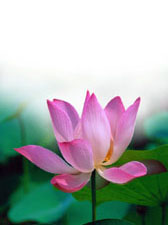
... Neben der systematischen Ordnung der Kana-Zeichen nach dem gojûon gibt es noch andere Zusammenstellungen, die nach mnemotechnischen Gesichtspunkten eingerichtet sind und ebenfalls während der Heian-Zeit entstanden: es sind dies die Merkverse taini, ametsuchi und iroha. Von ihnen hat sich nur das iroha durchgesetzt, das bereits in einer Sutrenglossierung aus dem Jahre 1079 überliefert ist und dem Mönch Kûkai (Kûbô-daishi, 774-835) zugeschrieben wird, wogegen allerdings manche Indizien sprechen. Das iroha ist in die Form eines buddhistischen geistlichen Liedes gekleidet (imayô-uta: 4 Verspaare zu je 7+5 Silben) und nimmt Bezug auf eine Stelle des Nirvâna-sûtra. Die Silbenordnung ist folgende i ro ha ni ho he to chi ri nu ru wo wa ka yo ta re so tsu ne na ra mu u wi no o ku ya ma ke fu ko e te a sa ki yu me mi shi we hi mo se su.
In sinngemäßer Transkription:
Iro wa nioedo / chirinuru wo,
Waga yo tare zo / tsune naramu,
Ui no okuyama / kyô koete,
Asaki yume miji / ei mo sezu
Übersetzung: Die Blüten duften zwar, doch sind sie abgefallen. Wer denn in unserer Welt wird unvergänglich sein? Die Berge fernab von den Wechselfällen (des Lebens) heute überschreitend, werde ich keine seichten Träume mehr träumen; bin auch nicht berauscht.
Während das gojûon-zu anfangs nur die katakana enthielt, war das iroha-uta aus hiragana zusammengesetzt. Das iroha-uta erfüllte bis Ende des 19. Jhs. die Aufgaben eines Alphabetes und wurde erst danach vom gojûon-zu aus dieser Position verdrängt, obgleich es auch noch heutzutage mitunter zur Rubrizierung herangezogen wird.
Bruno Lewin, Abriss der Japanischen Grammatik, auf der Grundlage der klassischen Schriftsprache, Seite 27, 1975, Otto Harrassowitz, Wiesbaden, Germany
... The Kana characters were organized according to the gojûon system, but they were also arranged in other ways, which were based on mnemonics and which also came into being during the Heian period: these are the taini, ametsuchi und iroha jingles. Of these three, only the iroha system stood the test of time. It is to be found in a sutra glossary from the year 1079 that is attributed to the Monk Kûkai (Kûbô-daishi, 774-835). There are some indications, however, that Kûkai may not have written this glossary. The iroha takes the form of a Buddhist religious song (imayô-uta: 4 couplets, each with 7+5 syllables) and refers to a section of the Nirvâna-sûtra. The syllables are arranged as follows: i ro ha ni ho he to chi ri nu ru wo wa ka yo ta re so tsu ne na ra mu u wi no o ku ya ma ke fu ko e te a sa ki yu me mi shi we hi mo se su.
In other words:
.
Iro wa nioedo / chirinuru wo,
Waga yo tare zo / tsune naramu,
Ui no okuyama / kyô koete,
Asaki yume miji / ei mo sezu
.
Translation:
The blooms have long since fallen from the flowers, but their fragrance
remains.
Who, amongst us, will live forever in this world?
Crossing the mountains far from the vagaries of life,
I'm not intoxicated and will dream no more those shallow dreams.
In the beginning, gojûon-zu contained the katakana only, and the iroha-uta contained hiragana. The iroha-uta was the alphabet used up until the end of the nineteenth century. It was then superseded by gojûon-zu which was used from that time onwards, although the iroha-uta is still sometimes used for rubrication.
Bruno Lewin, Summary of Japanese grammar, based on the classical written language, Page 27, 1975, Otto Harrassowitz, Wiesbaden, Germany

.